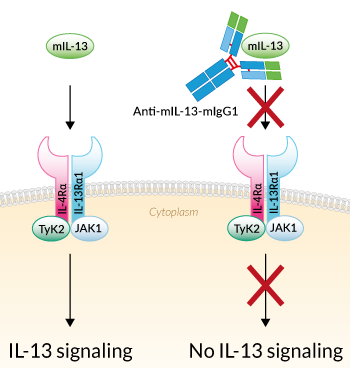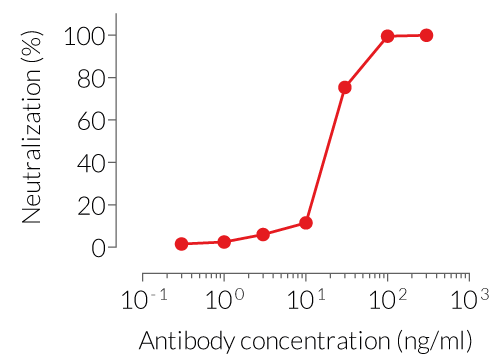Recombinant anti-mouse IL-13 antibody
| Product | Unit size | Cat. code | Docs. | Qty. | Price | |
|---|---|---|---|---|---|---|
|
Anti-mIL-13-mIgG1 Recombinant mouse mAb against mIL-13 (clone 8H8). For in vitro use. |
Show product |
200 µg |
mil13-mab9-02
|
|
||
|
Anti-mIL-13-mIgG1 InvivoFit™ Recombinant mouse mAb against mIL-13 (clone 8H8). For in vivo use. |
Show product |
1 mg |
mil13-mab9-1
|
Notification: Our anti-mouse IL-13 antibody raised in mice and produced in hybridoma (mabg-mil13/mabg-mil13-5) has been removed from our catalog. Its coding sequence has been determined and the antibody is now produced by recombinant technology and purified from CHO cells.
Recombinant mouse IL-13 antibody

Neutralizing monoclonal antibody against murine IL-13
InvivoGen provides a recombinant fully mouse anti-mouse IL-13 monoclonal antibody (mAb) that was previously extracted from hybridoma. It is now expressed and produced in Chinese hamster ovary (CHO) cells, ensuring reliability and lot-to-lot reproducibility. Thereby, common hybridoma-related drawbacks such as the generation of non-relevant mAbs containing aberrant light chains are avoided [1].
The sequence of Anti-mIL-13-mIgG1 is 100% murine (constant and variable regions), as the original clone (clone 8H8) was raised in mice using a proprietary method. This feature allows for reduced immunogenicity and risks of fatal hypersensitivity reactions upon repeated mAb injections into mice [2-4].
InvivoGen provides this antibody in two grades:
- In vitro use: Anti-mIL-13-mIgG1
- In vivo use: Anti-mIL-13-mIgG1 InvivoFit™
All InvivoFit™ products are handled in a clean room, filter-sterilized, and tested for bacterial contaminants. Additionally, this grade guarantees low levels of endotoxins (<1 EU/ml). The buffer formulation is specifically adapted for in vivo studies.
Key features:
- Potent and specific neutralizing activity against mIL-13
- Sequence is 100% murine
- Murine IgG1 isotype (constant region)
- Free from non-relevant mAbs found in hybridoma-based productions
- Produced in animal-free facilities and defined media
- Low aggregation < 5%
- InvivoFit™ grade is available
Anti-mIL-13-mIgG1 is designed to efficiently neutralize the biological activity of mIL-13. Interleukin (IL-)13 is a multifunctional cytokine that plays an important role in the regulation of inflammation and immune responses [5,6].
References:
1. Bradbury, A. et al., 2018. When monoclonal antibodies are not monospecific: Hybridomas frequently express additional functional variable regions. mAbs, 10(4), 539–546.
2. Mall C. et al., 2016. Repeated PD-1/PD-L1 monoclonal antibody administration induces fatal xenogenic hypersensitivity reactions in a murine model of breast cancer. Onco Immunol. 5(2):e1075114.
3. Murphy, J.T. et al., 2014. Anaphylaxis caused by repetitive doses of a GITR agonist monoclonal antibody in mice. Blood. 123(14):2172-2180.
4. Belmar N.A. et al., 2017. Murinization and H chain isotype matching of Anti-GITR antibody DTA-1 reduces immunogenicity-mediated anaphylaxis in C57BL/6 mice. J Immunol. 198:4502-4512.
5. Kasaian M.T. et al., 2013. An IL-4/IL-13 dual antagonist reduces lung inflammation, airway hyperresponsiveness, and IgE production in mice. Am J Respir Cell Mol Biol.49(1):37-46.
6. David M. et al., 2003. Functional characterization of IL-13 receptor a2 gene promoter: a critical role of the transcription factor STAT6 for regulated expression. Oncogene 22, 3386-94.
Specifications
Target: Murine IL-13 (mIL-13)
Specificity: No cross-reactivity with human IL-13
Clone: 8H8
Source: CHO cells
Isotype: Murine IgG1, kappa
Control: Murine IgG1 Isotype Control
Formulation of Anti-mIL-13-mIgG1: Lyophilized from 0.2 µm filtered solution in a sodium phosphate buffer with glycine, saccharose, and stabilizing agents
Formulation of Anti-mIL-13-mIgG1 InvivoFit™: Lyophilized from 0.2 µm filtered solution in a sodium phosphate buffer with 5% saccharose and 0.25% Polysorbate 80
Quality control:
- These products have been validated using neutralization cellular assays.
- The complete sequence of these antibodies has been verified.
- The absence of bacterial contamination (e.g. lipoproteins and endotoxins) has been confirmed using HEK-Blue™ TLR2 and HEK‑Blue™ TLR4 cells.
- The endotoxin level in Anti-mIL-13-mIgG1 InvivoFit™ is <1 EU/mg (determined by a LAL assay).
Contents
Please note: each mAb is sold separately.
Anti-mIL-13-mIgG1
- mil13-mab9-02: 200 µg, lyophilized
Anti-mIL-13-mIgG1 InvivoFit™
- mil13-mab9-1: 1 mg, lyophilized
![]() The product is shipped at room temperature.
The product is shipped at room temperature.
![]() Store lyophilized antibody at -20 °C.
Store lyophilized antibody at -20 °C.
![]() Lyophilized product is stable for at least 1 year.
Lyophilized product is stable for at least 1 year.
![]() Avoid repeated freeze-thaw cycles.
Avoid repeated freeze-thaw cycles.
InvivoFit™
InvivoFit™ is a high-quality standard specifically adapted to in vivo studies. InvivoFit™ products are filter-sterilized (0.2 µm) and filled under strict aseptic conditions in a clean room. The level of bacterial contaminants (endotoxins and lipoproteins) in each lot is verified using a LAL assay and a TLR2 and TLR4 reporter assay.
Back to the topDetails
Interleukin 13 (IL-13) is a pleiotropic cytokine that plays an important role in inflammation, fibrosis, allergic diseases and cancer. It is mainly produced by activated T cells and regulates several subtypes of T helper (Th) cells by affecting their transformation, including Th1, Th2, and Th17 cells. Previous studies have revealed that IL-13 is implicated in the pathogenesis of autoimmune diseases, such as systemic lupus erythematosus (SLE), rheumatoid arthritis (RA), and type 1 diabetes (T1D) [1].
IL-13 also exerts its anti-inflammatory effects by inhibiting the production of pro-inflammatory cytokines, such as TNF‑α. The biological functions of IL-13 overlap with those of IL-4. In fact, both IL-4 and IL-13 can bind to the same receptor complex, IL-13 receptor (IL-13R), which is composed of two subunits IL-4Rα and IL-13Rα1 [2]. The binding of IL-4 or IL-13 to IL-13R instigates a signaling cascade involving the activation of receptor-associated Janus kinases (JAK1 and Tyk2) and the nuclear translocation of STAT6 (Signal Transducer and Activator of Transcription 6). The nuclear translocation of STAT6 ultimately leads to the induction of gene expression by IL-13 [3].
References:
1. Mao YM, et al., 2019. Interleukin-13: A promising therapeutic target for autoimmune disease. Cytokine Growth Factor Rev.;45:9-23.
2. David M. et al., 2003. Functional characterization of IL-13 receptor a2 gene promoter: a critical role of the transcription factor STAT6 for regulated expression. Oncogene 22, 3386-94.
3. Dickensheets H.L. et al., 1999. Interferons inhibit activation of STAT6 by interleukin 4 in human monocytes by inducing SOCS-1 gene expression. PNAS. 96(19):10800-5.






